Dolmadakia – Stuffed Grape Leaves are one of the most iconic Greek foods. Our vegan version features lots of dill, mint, scallions, and tender rice, and is a delicacy not to be missed!
If you love Dolmadakia-Stuffed Grape Leaves, you will also love our Spanakorizo-Rice with Spinach, Gemista -Stuffed Tomatoes, or Stuffed Squash Blossoms!
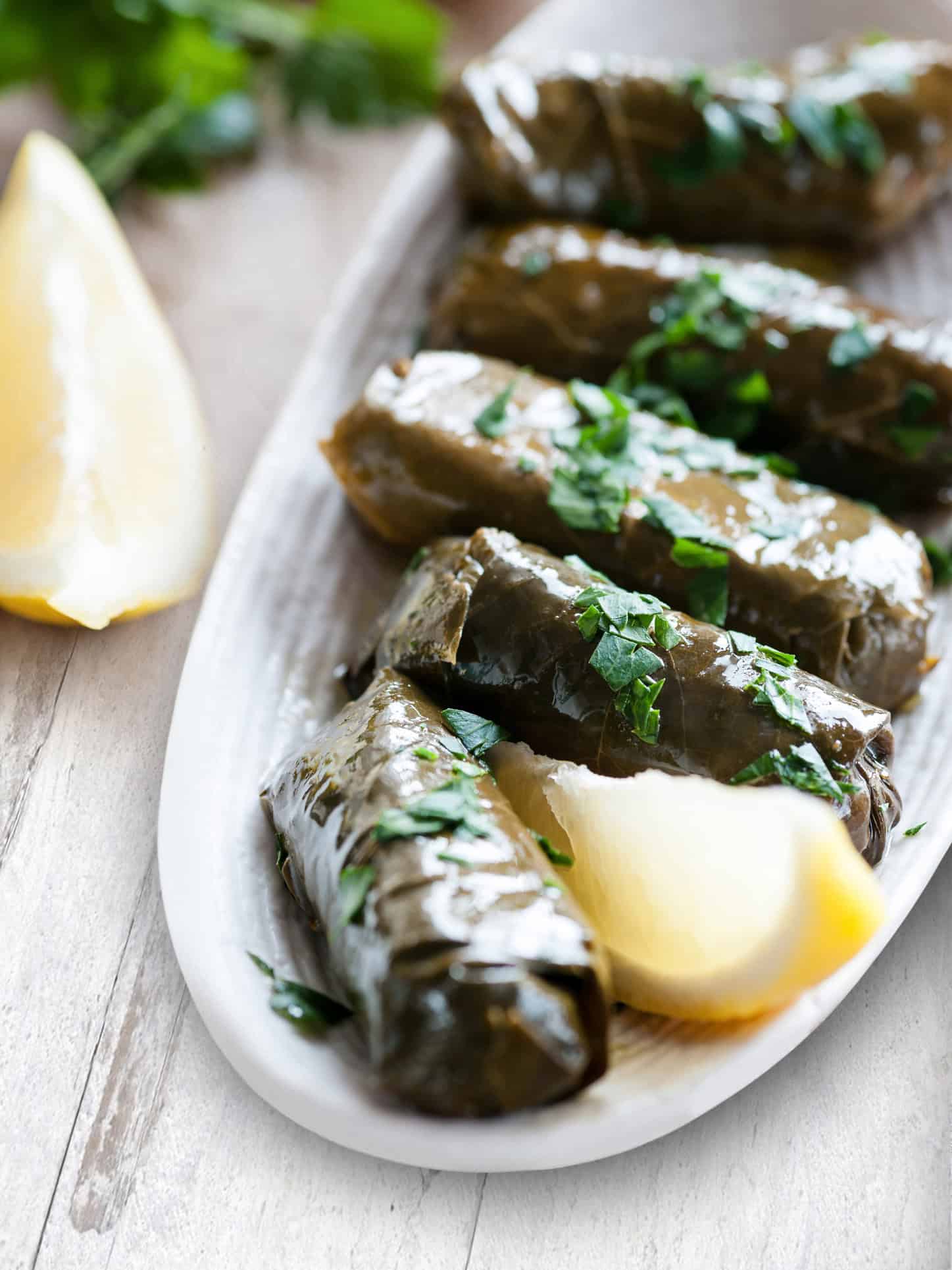
What cooks say:
“They have a delicate, but tangy taste. I really appreciate the pictures showing the steps to follow. Thank you for sharing your heritage and culture with us.”
SORAYA S.
Why you will love dolmadakia
Here is what you need for stuffed grape leaves
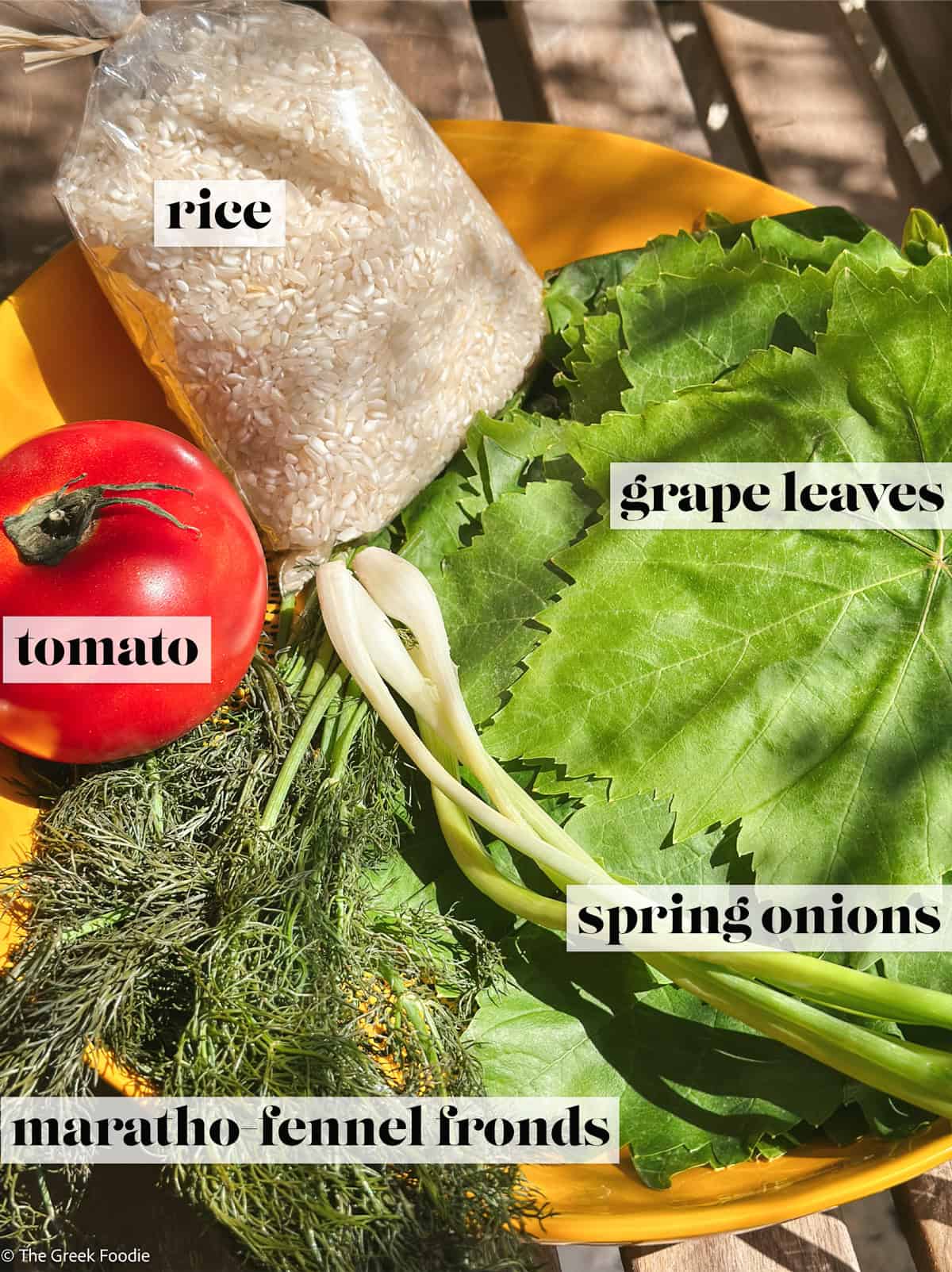
- Grape leaves: In Greece, you find fresh grape leaves in the spring and summer, but in the US, you are most likely to find them jarred. Both work great. See recipe card for instructions on how to prep the leaves.
- Spring onions, a tomato, various herbs, and rice.
- Fennel fronds. In Greece, they are called maratho. In Crete, they mostly use wild maratho, which is gathered from fields. Maratho is particularly tufted, with thin dense leaves. It has an intense aroma and a sweet and slightly bitter flavor. Here, we use about half a cup of finely chopped fennel fronds. The taste is mild and sweet, though without the intense aroma of the wild fennel.
Detailed measurements and instructions can be found on the recipe card at the bottom of the page.
Step by step
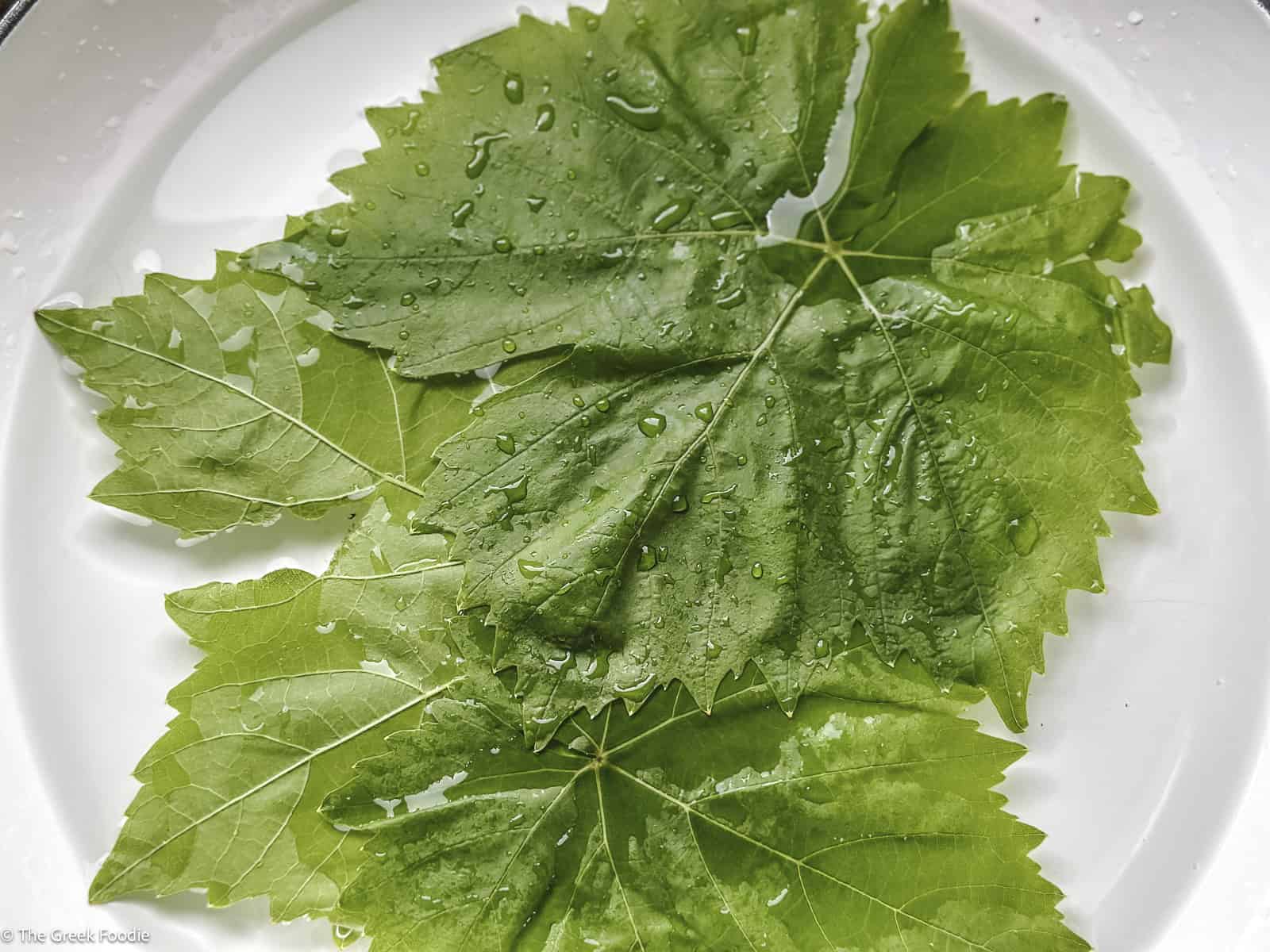
Step 1: Prepare the grape leaves (see recipe card for instructions).
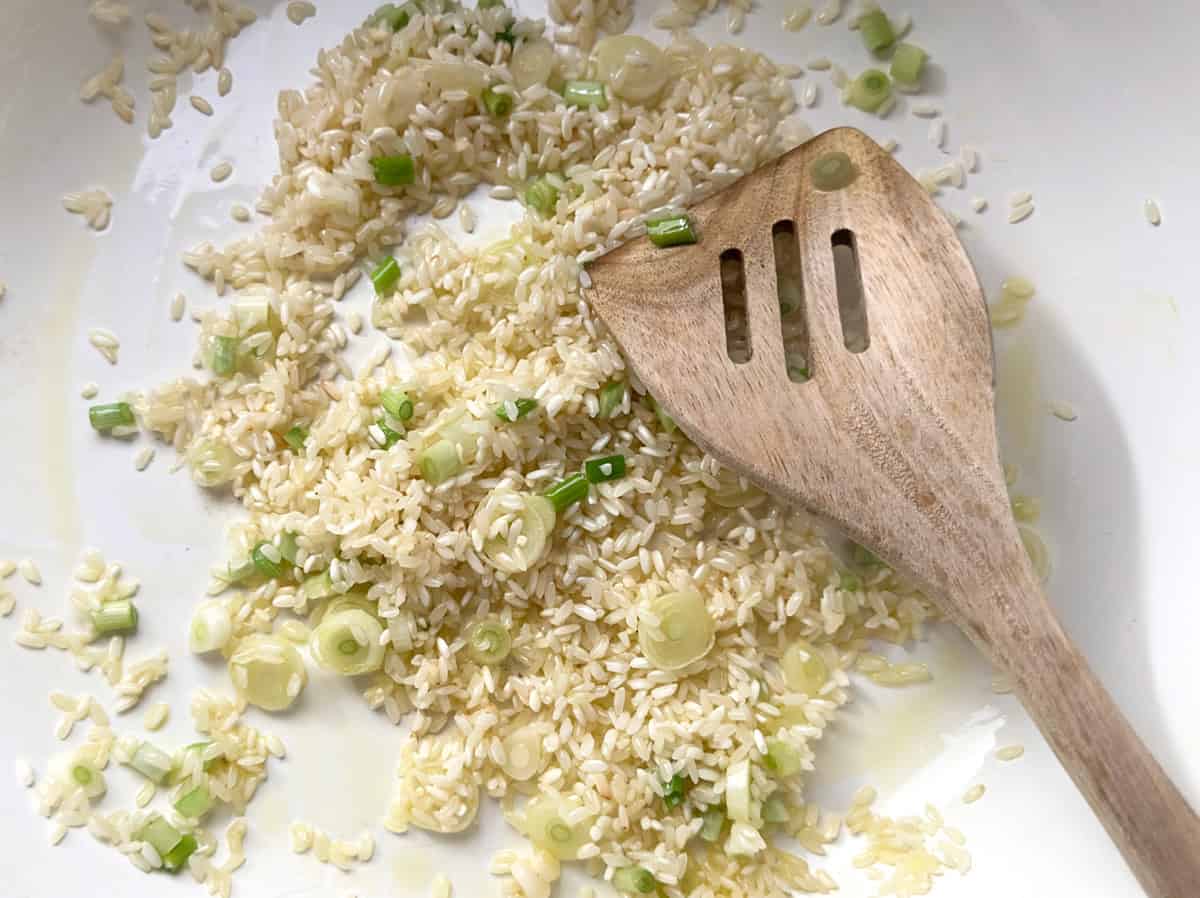
Step 2: Saute the chopped spring onions and rice with one tablespoon of olive oil for 3-4 minutes.
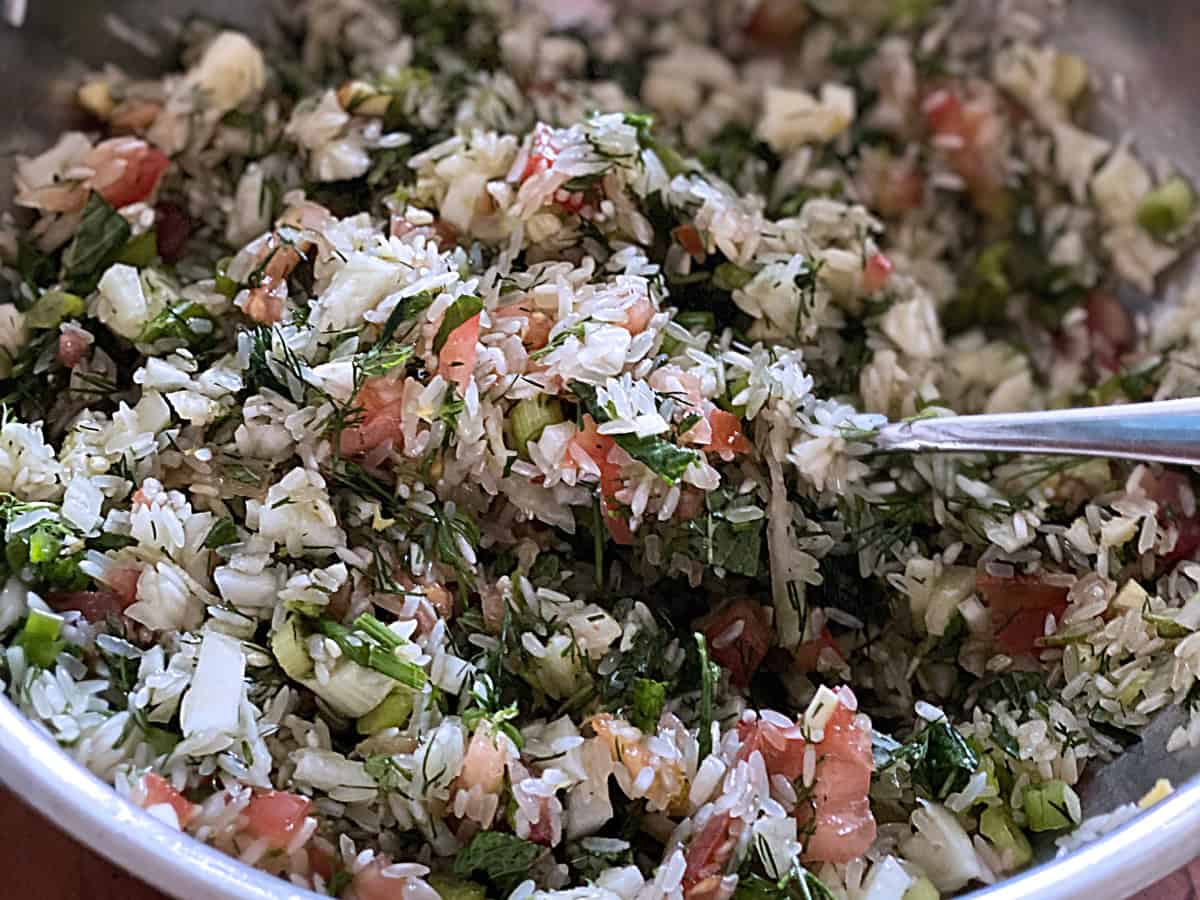
Step 3: Mix the rice, spring onions, dill, fennel, mint, and tomato with ½ cup olive oil—season with sea salt and freshly ground pepper.
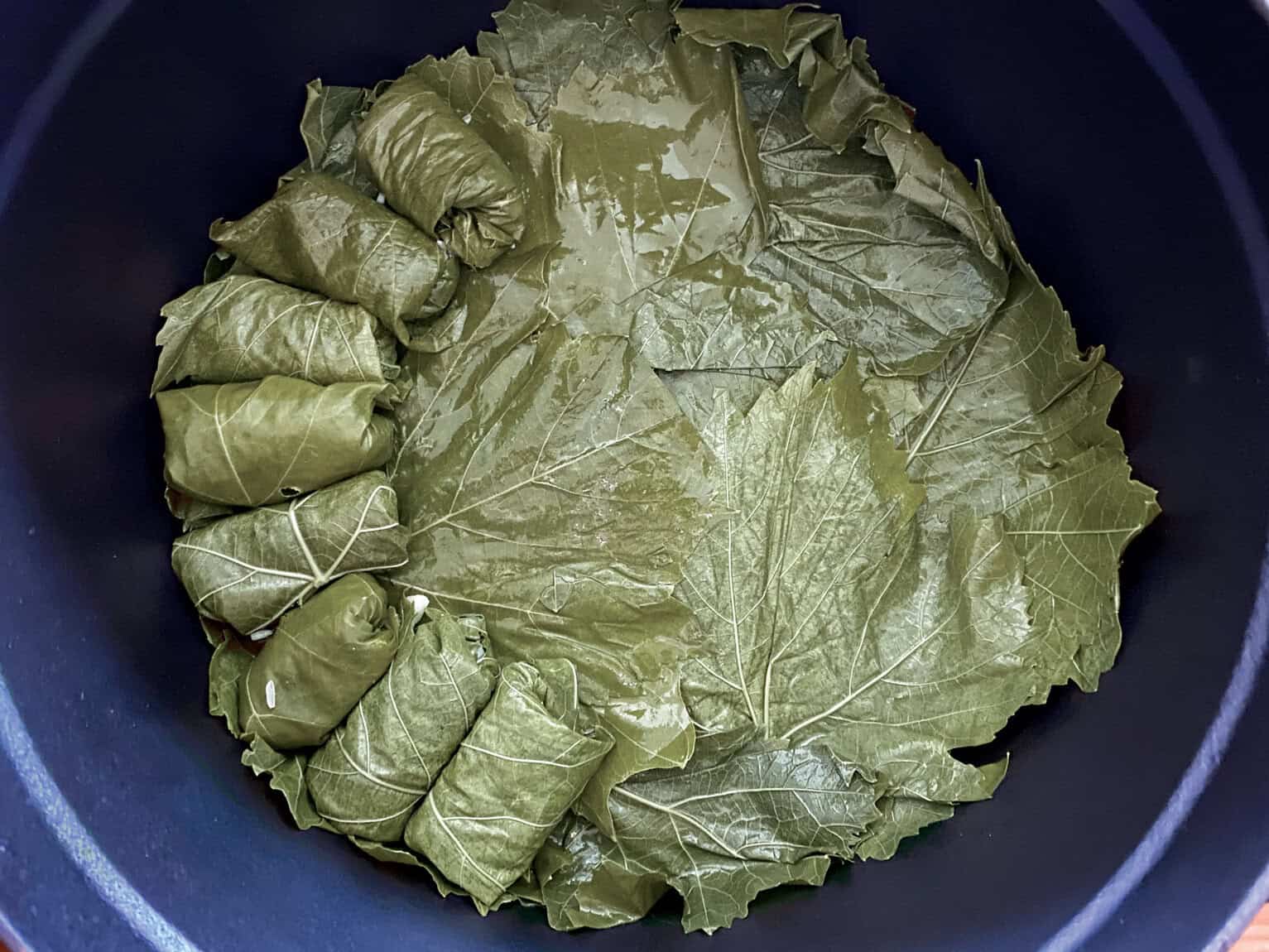
Step 4: Fold the dolmadakia(see our step-by-step guide below).

Step 5: Line the bottom of a large pot with three layers of grape leaves. Place each roll seam side down.
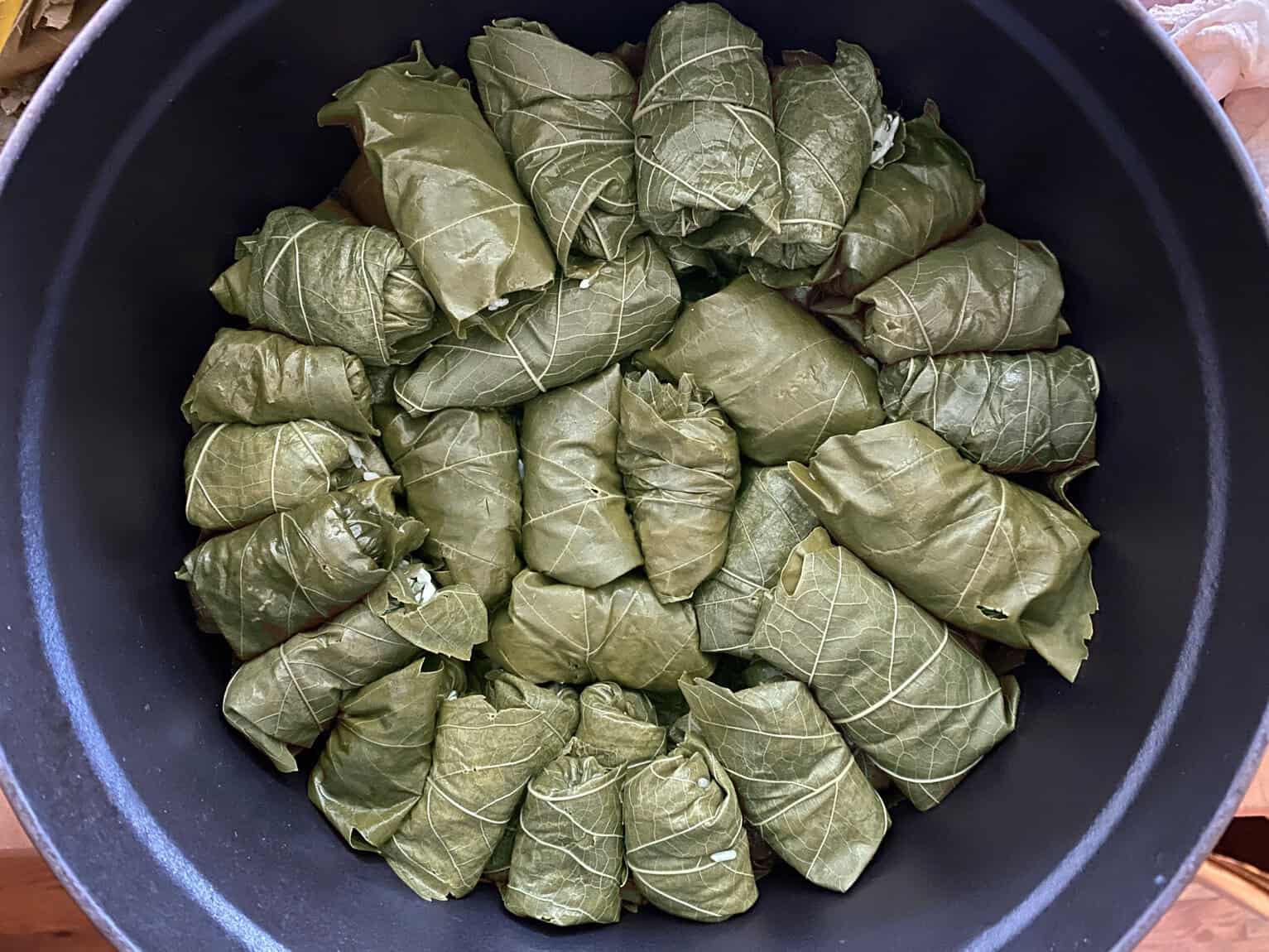
Step 6: Continue with the remaining stuffed leaves, placing them tightly together in the pot. Do a second layer if necessary.
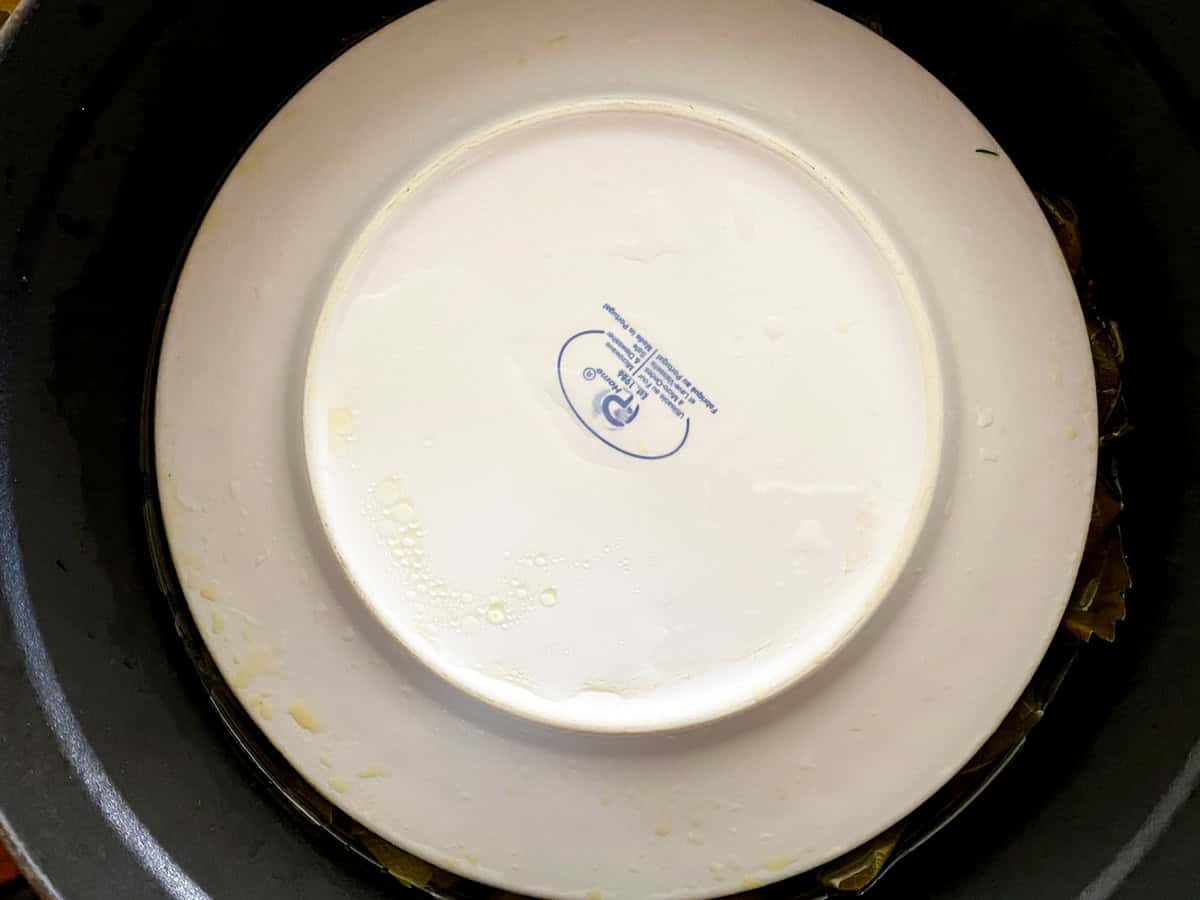
Step 7: Add the remaining ½ cup of oil and enough warm water or broth to cover the leaves. Place a plate upside down over the leaves to keep them from moving.
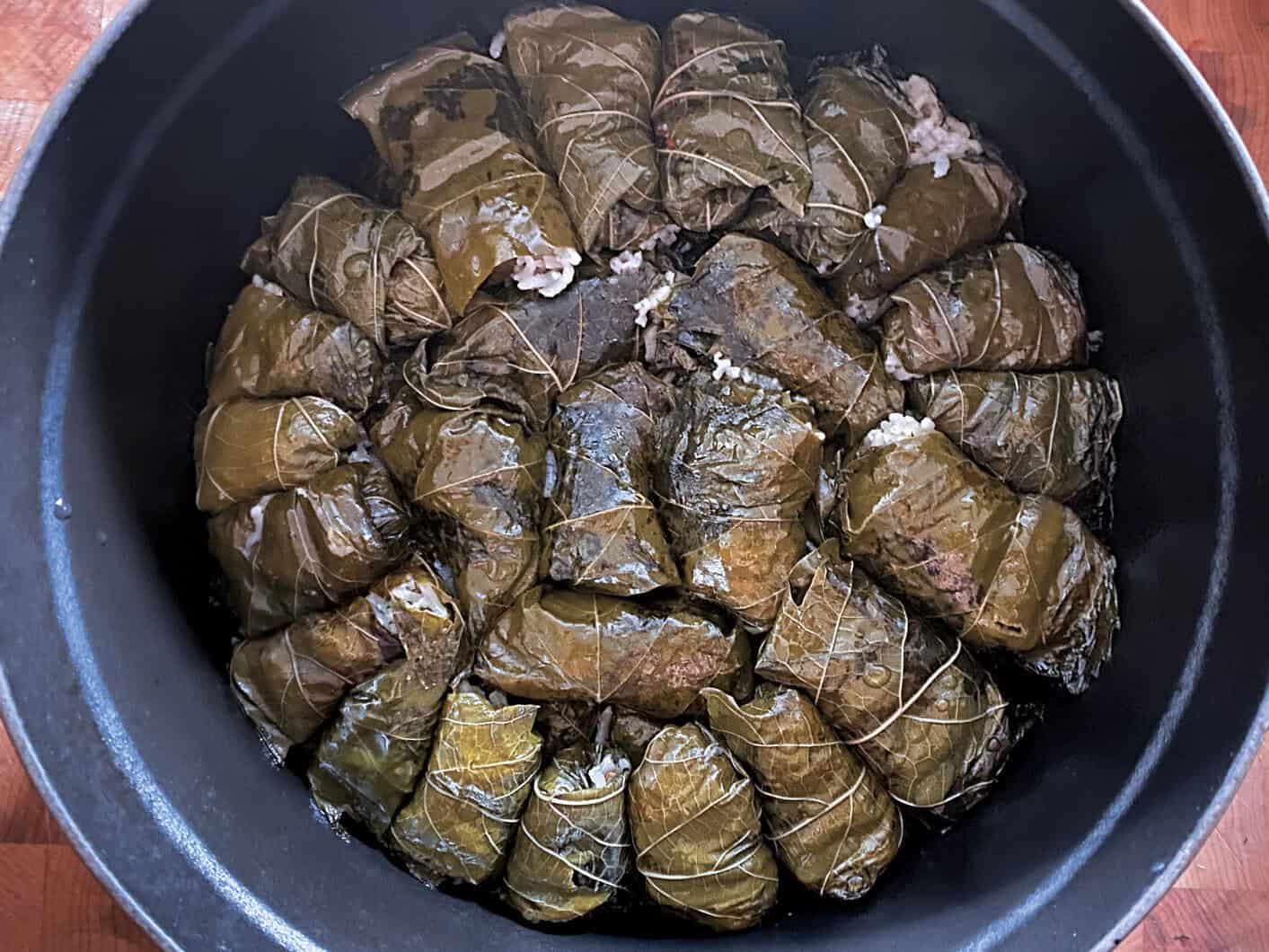
Step 8: Bring to a simmer over medium heat, lower the heat to medium-low, cover the pan, and cook until the rice and leaves are tender, about 50-60 minutes.
How to fold a dolmadaki
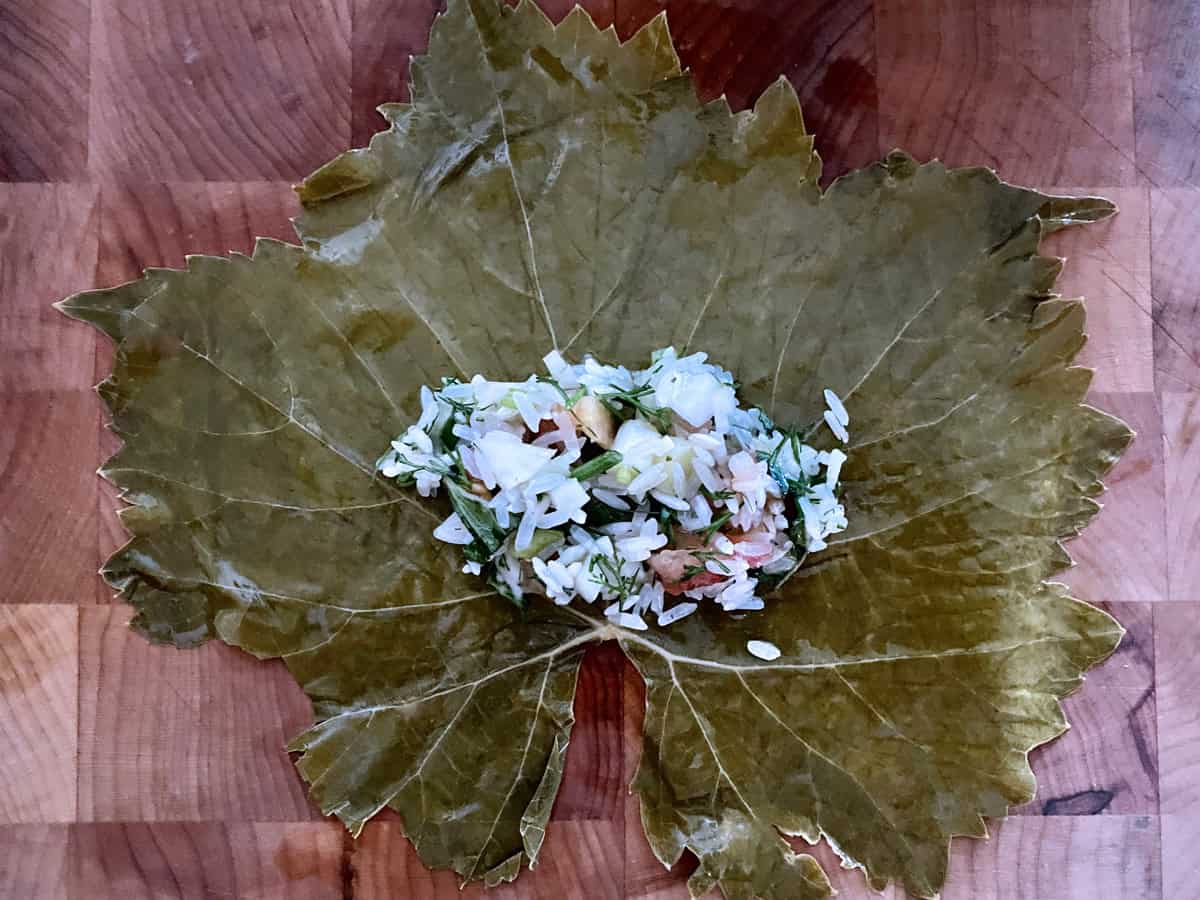
- Place a generous tablespoon of filling in the center of a leaf.
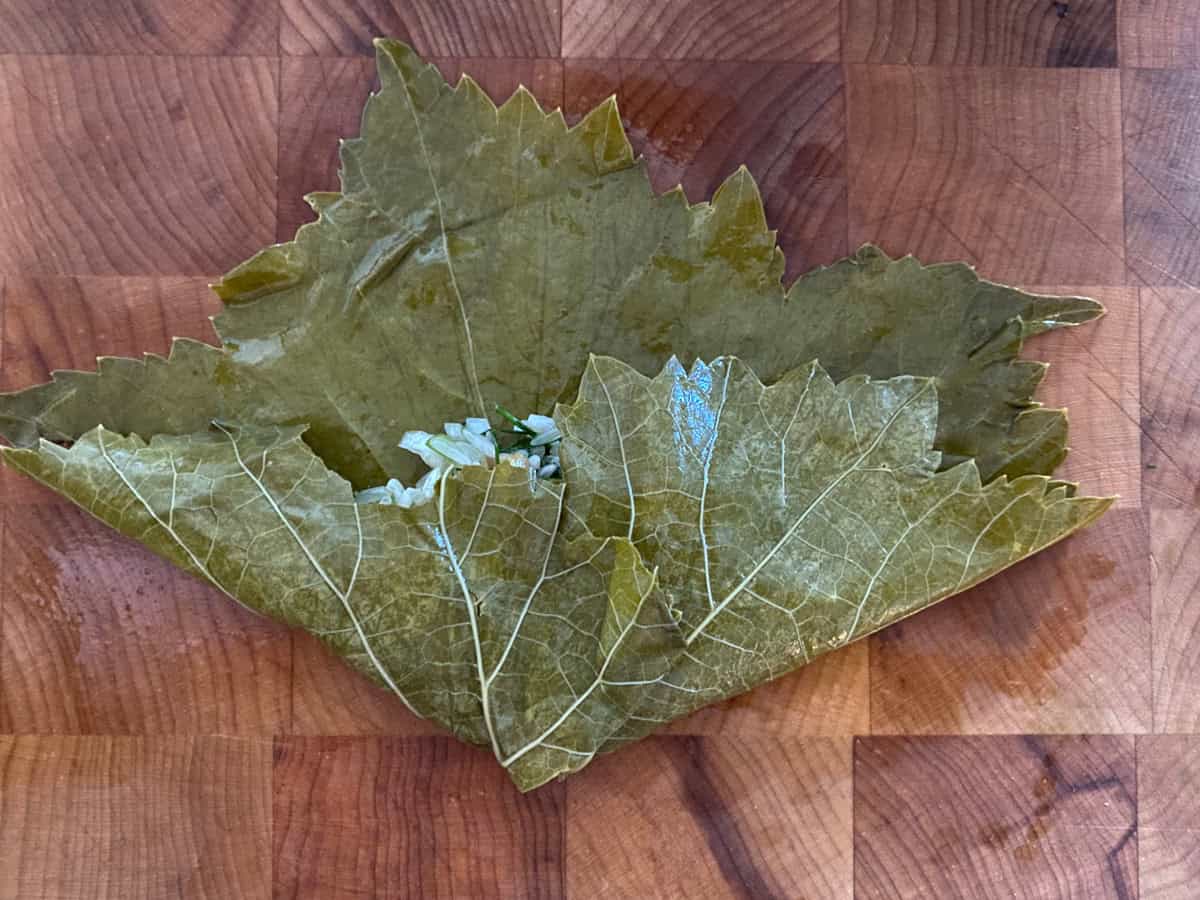
- Fold the bottom sides of the leaf over the filling. Make them overlap each other
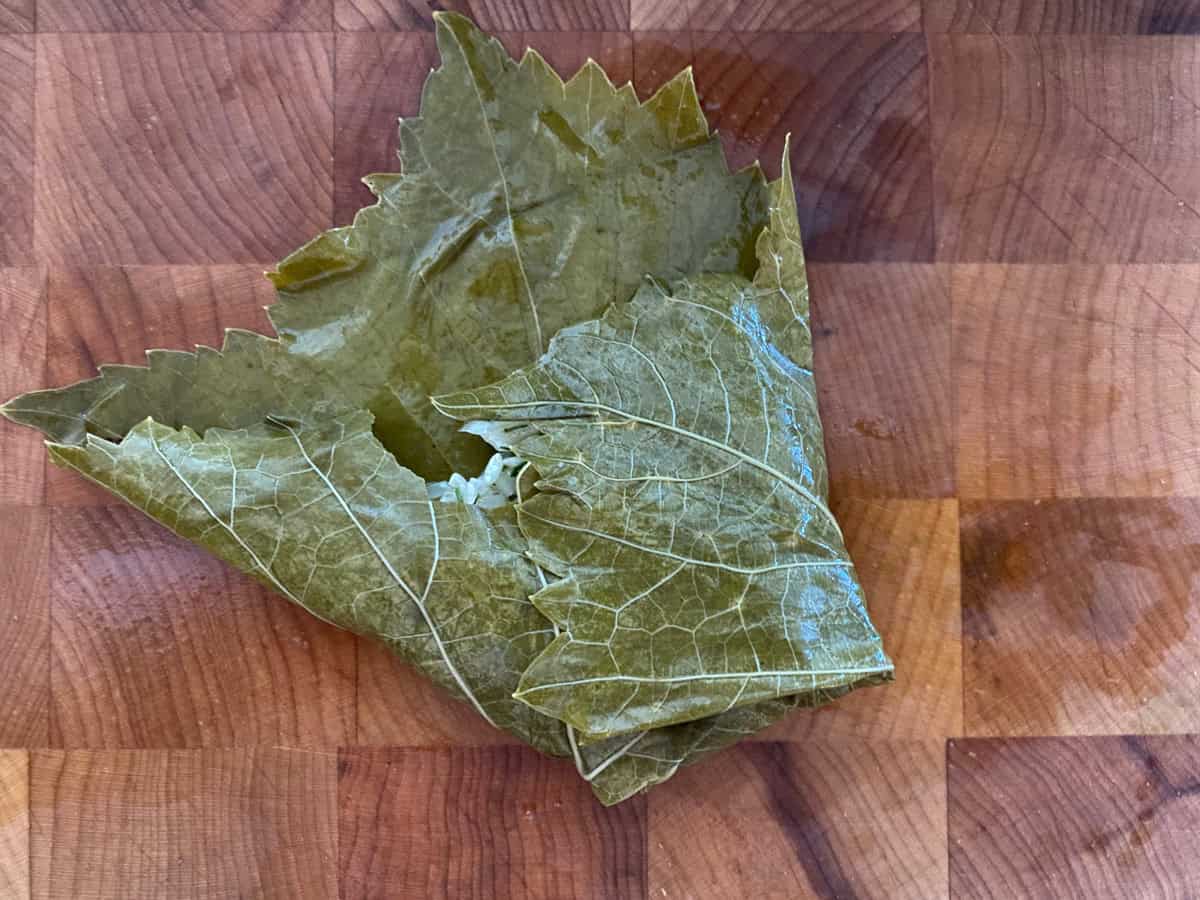
- Fold the left…
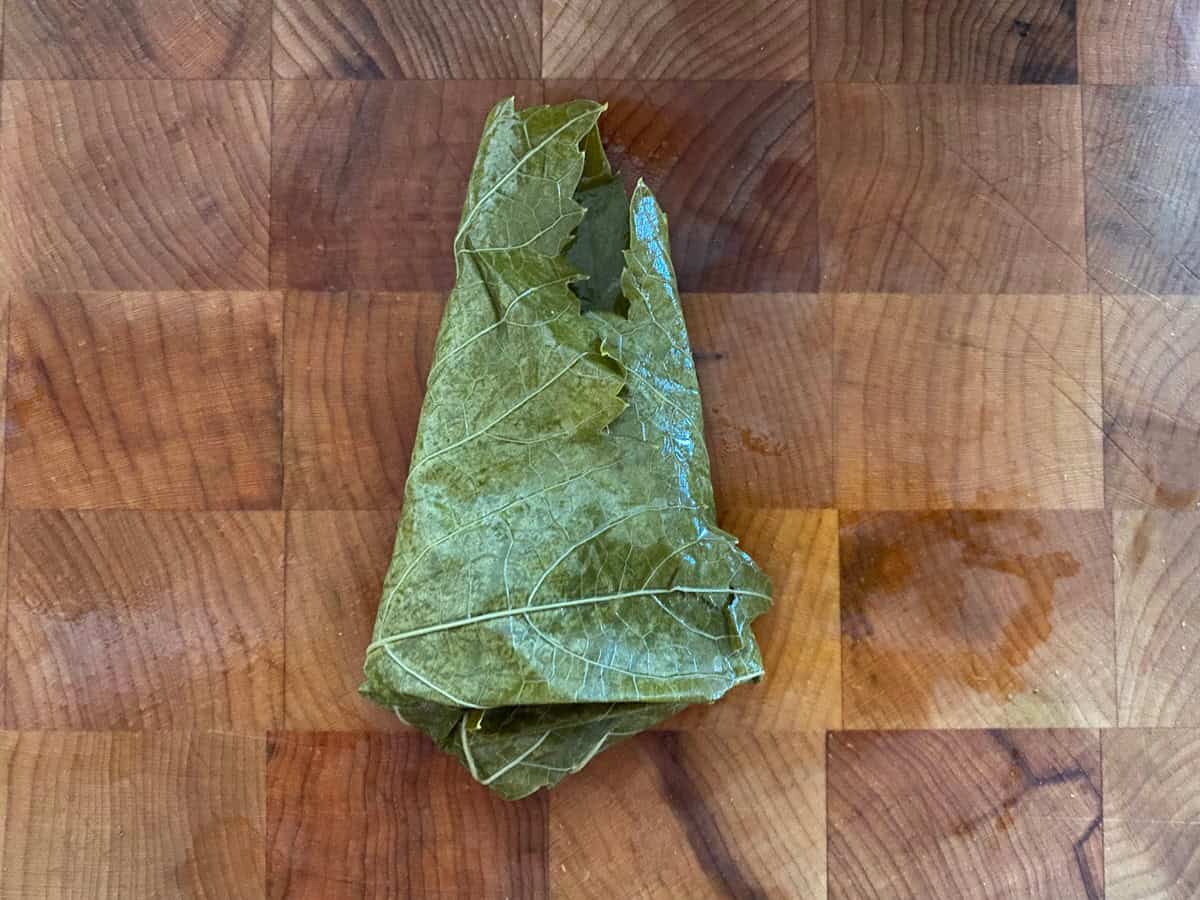
- and the right sides over.
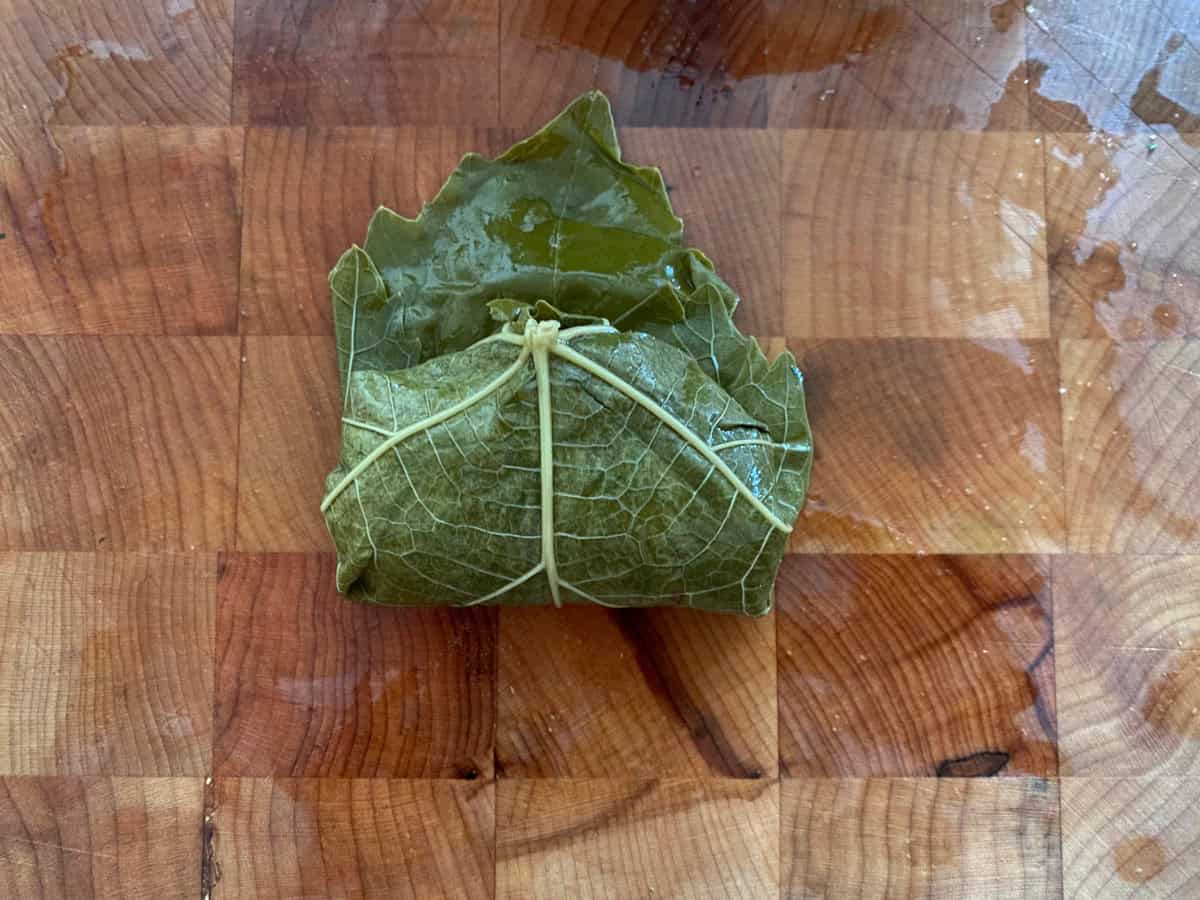
- Roll tightly…
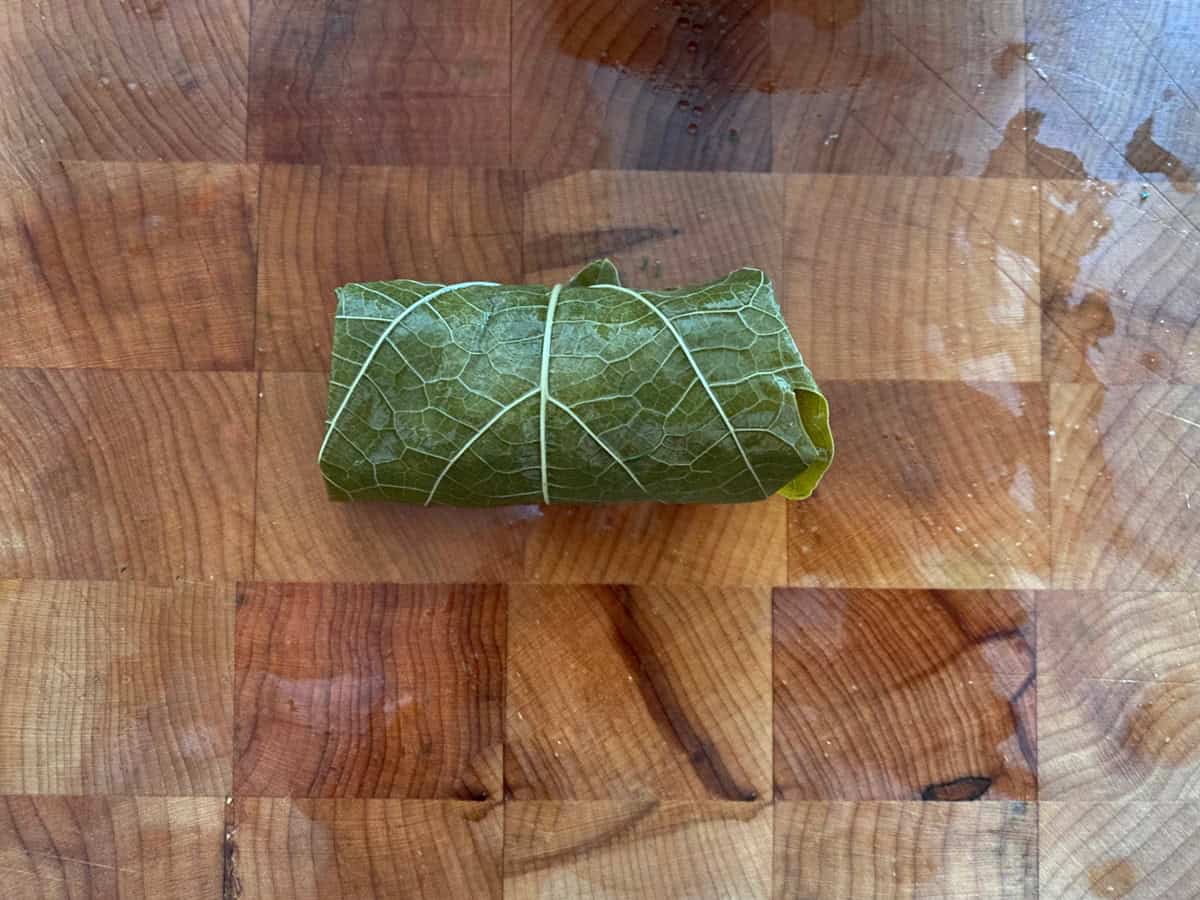
- to make a roughly 2-inch by half an inch cigar shape
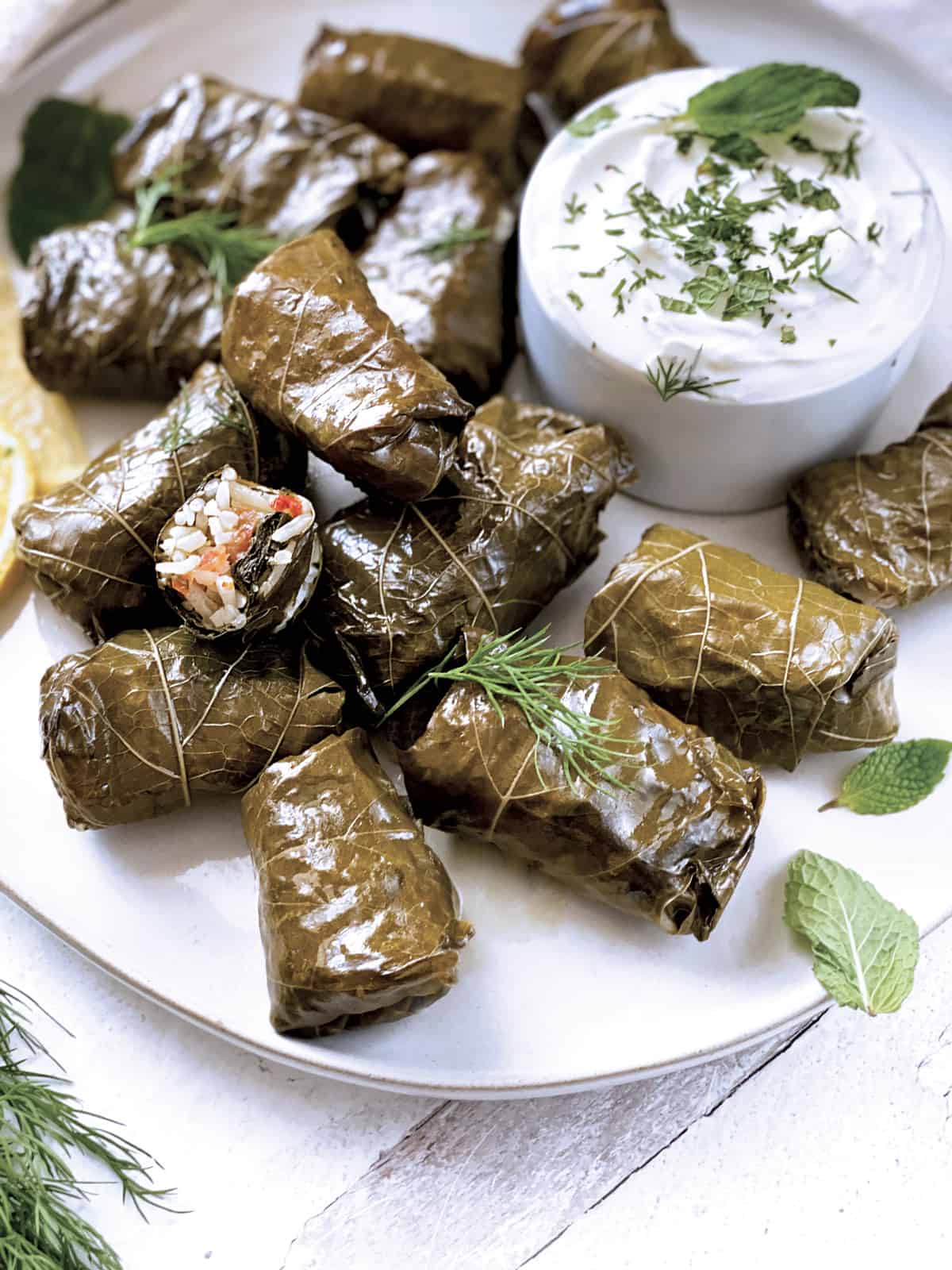
Side dishes to try with dolmadakia
- Kalitsounia-hand pies – These savory hand pies from Crete are filled with cheese or herbs and would complement the flavors of Greek stuffed grape leaves nicely.
- Boureki-potatoes and zucchini pie– The delicious savory pie with potatoes and zucchini is a summertime staple dish in Crete but can easily be enjoyed year-round.
- Eggplant fritters – These flavorful fritters have a natural sweetness and would add some variety to the meal.
- Tzatziki yogurt dip – Another classic in Mediterranean cuisine, the garlicky yogurt dip would be a tasty accompaniment to dolmadakia.
- Lemon Roasted Potatoes – Roasted potatoes with lemon and herbs would add brightness and a nice contrast to the dolmadakia.
Helpful Q&A
Dolmadakia (or dolmades) can be vegan or with meat. The vegan version is the most common one, with the grape leaves stuffed with rice and lots of herbs, and is served at room temperature with a yogurt sauce on the side. In Crete, they might add grated eggplant, zucchini, or artichokes in their dolmades. The vegan version is also called dolmadakia gialantzi (it means fake dolmadakia in Turkish, due to the absence of meat). The meat version is often called dolmades; they are bigger, have ground meat, rice, and herbs as stuffing, and are served warm with thick avgolemono sauce.
The idea of a wrapped stuffed grape leaf has existed since ancient Greece. The tale says that on the west gable of the Parthenon, the goddess Hera is depicted eating hidden dolmades from the pot. She has a guilty look on her face, glancing behind so no one can see.
In Ancient Greece, they stuffed fig leaves with sweet cheese. Stuffed vegetables-gemista are also common in modern Greek cuisine.
Greeks were under Ottoman occupation for 400 years, liberating themselves with a revolution starting in 1821. It’s natural that the two cuisines blend and influence each other.
Dolmadakia means little dolmades.
The word dolma (dolmades in plural) is of Turkish origin from the word dolmak (to fill). Middle Eastern cuisines have been using stuffed grape leaves for centuries.
They can be eaten as a side dish, an appetizer, or a main meal. Dolmadakia filled with rice are best at room temperature or chilled. Drizzled with olive oil and served alongside lemon wedges for squeezing. Dip or top them with Greek yogurt for extra flavor.
Fresh grape leaves can be more tender and flavorful than jarred leaves, you can find them in farmers’ markets and grocery stores in the late spring/summer. However, when out of season, leaves preserved in glass jars are a great substitute. Jarred grape leaves are available at most grocery stores and any Greek, Turkish, and Middle Eastern market. You can also find them online.
More traditional Greek dishes

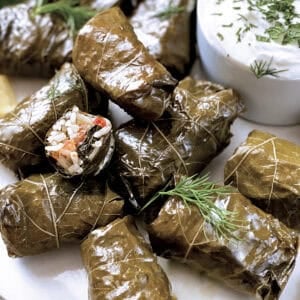
Dolmadakia-Stuffed Grape Leaves
Equipment
- Large pot
- Small strainer
Ingredients
- 60-70 grape leaves or a 16.oz jar-stems removed
- 1 cup extra virgin olive oil plus a tablespoon for sauteing the rice
- 4 spring onions sliced. Substitute with one onion finely diced. See notes below.
- 1 ripe tomato finely diced or grated, juices included.
- ½ cup fennel fronds finely chopped
- 2 cups rice Carolina
- ½ cup finely chopped fresh mint
- ½ cup finely chopped dill
- 2 cups vegetable broth optional; you can use water instead. You might not need all of the broth.
- sea salt
- freshly ground pepper
For the yogurt sauce
- 1 lb Greek yogurt
- 1 tablespoon extra virgin olive oil
- ½ cup finely chopped fresh dill
- ½ cup finely chopped fresh mint
- freshly ground pepper
- extra virgin olive oil for serving
Instructions
Fresh grape leaves preparation
- Boil leaves for 2-3 minutes in salted water. Remove with a slotted spoon and transfer in a bowl of ice-cold water. Drain leaves in a colander.Using a sharp knife remove the stalks and any thick nerves that may be on some of the leaves.
Jarred grape leaves in brine preparation
- Take leaves out of the jar, put them in a colander, rinse them well with cold water and let them drain.
Stuff and roll the grape leaves
- Add one tablespoon of olive oil in a medium sauce pan and saute the spring onions and rice for three to four minutes (See notes below).
- In a large bowl, mix the rice, scallions, dill, mint, fennel, and tomato (with its juices) with ½ cup olive oil, one teaspoon of sea salt, and some freshly ground pepper.
- Line the bottom of a large pot with 3 layers of grape leaves.
- Place a generous tablespoon of filling in the center of each leaf, then fold the bottom sides of the leaf over the filling. Make them overlap each other.Fold the left and right sides over, then roll tightly to make a roughly 2-inch by ½–inch cigar shape.
- Place the roll, seam side down, in the lined pot. Continue with the remaining leaves and filling, placing them tightly together in the pot and continuing onto a second layer if necessary.
- Add the remaining ½ cup of oil and just enough warm water -or broth to cover the leaves. Place a plate upside down over leaves to keep them from moving. Bring to a simmer over medium heat, lower the heat to medium-low, cover the pan, cook until the rice and leaves are tender, about 45 minutes.
- Remove the pot and let the dolmadakia cool.
Make the yogurt sauce
- In a bowl, mix the yogurt with the chopped dill and mint and a tablespoon of olive oil.
- Serve the dolmadakia at room temperature or chilled, drizzled with olive oil and alongside lemon wedges for squeezing and the Greek yogurt sauce for dipping or topping.
Notes
- Naturally, you will lose some of the leaves due to tearing or holes that might be already on them. Don’t discard them; use the broken leaves to line the pot. The lining will prevent scorching the dolmadakia while cooking.
- You can mix the spring onions and rice with the remaining ingredients without sauteing them first. Sauteing intensifies the flavor and sweetens the onions, but it is not necessary.
- Grate zucchini and a small eggplant and add it to the rice mixture for another Cretan variety of these dolmades. When in the season, you can also add a grated artichoke heart.
- Do you have leftover rice mixture? Stuff some veggies, tomatoes, zucchini, eggplant, and bell peppers with the delicious mixture. After you take out the flesh from the veggies, add it to the rice. Next, you can bake the veggies with broth and olive oil in the oven. Check out this cooking method for gemista.
- Want to make sure dolmadakia are fully cooked? After 45 minutes, uncover the pot and carefully lift the plate with the help of a fork. Take one dolma out with the fork, wait for it to cool, and try it. Is the rice cooked fully? If not, cover the rest of the dolmades with the plate and cook until the rice is soft and fully cooked. If needed, add a little hot water -or broth (don’t overdo it with the water).
Nutrition
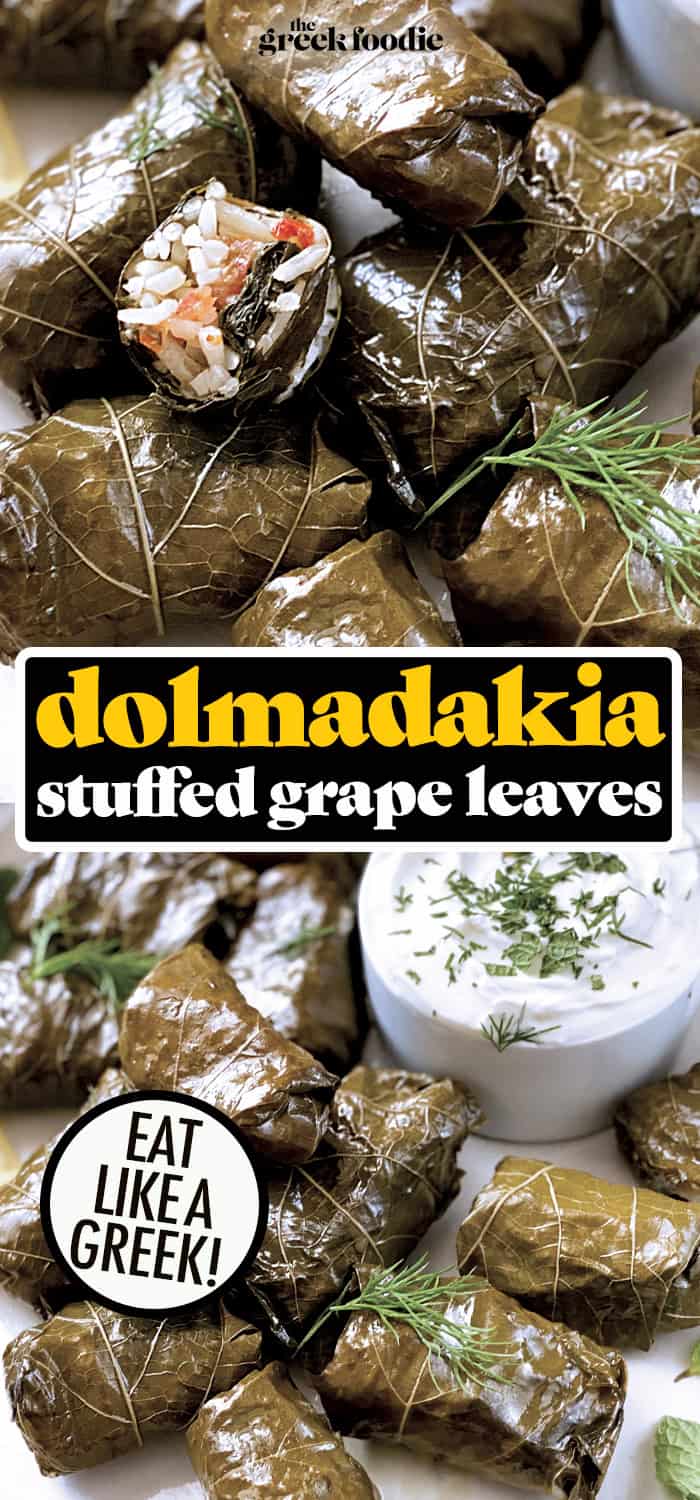


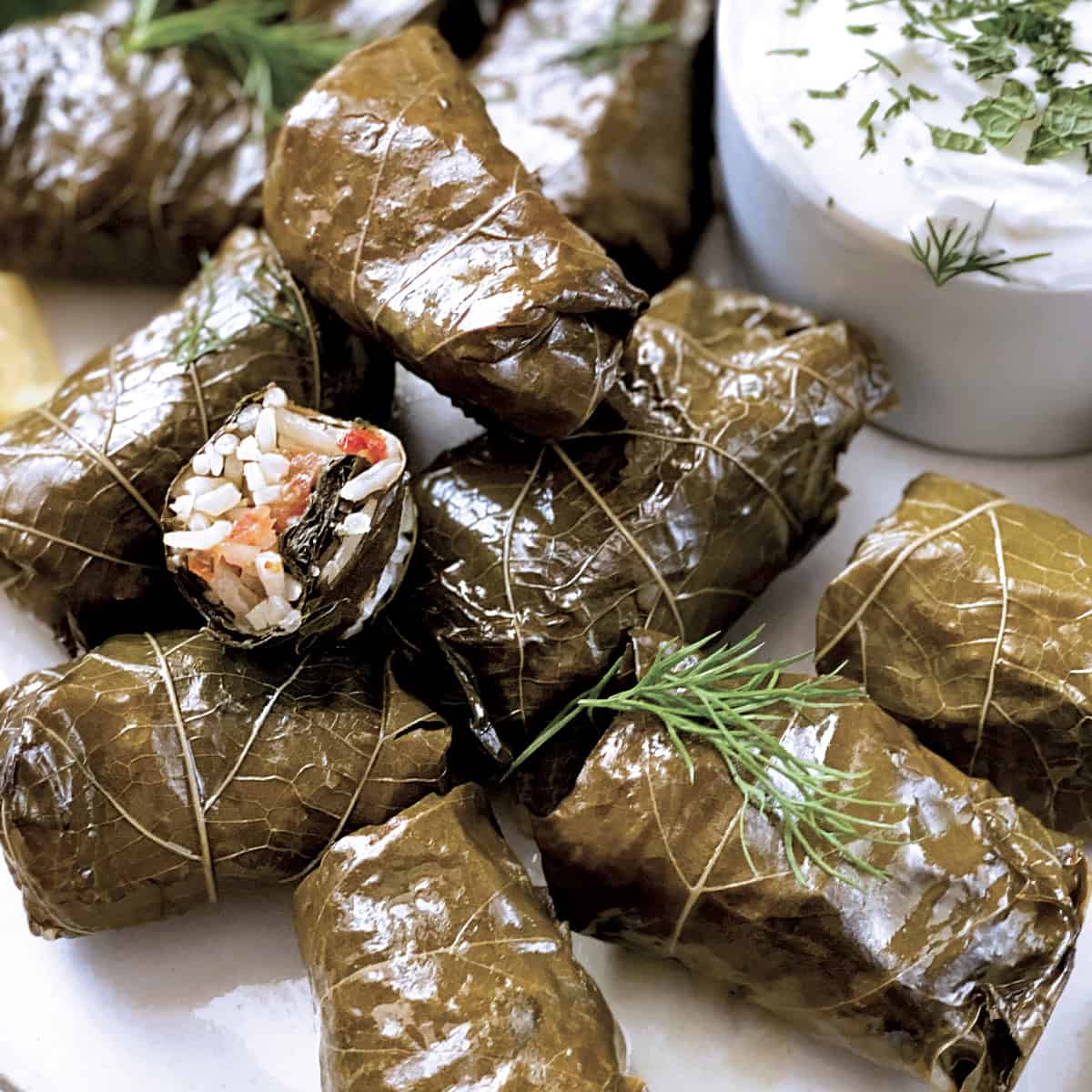
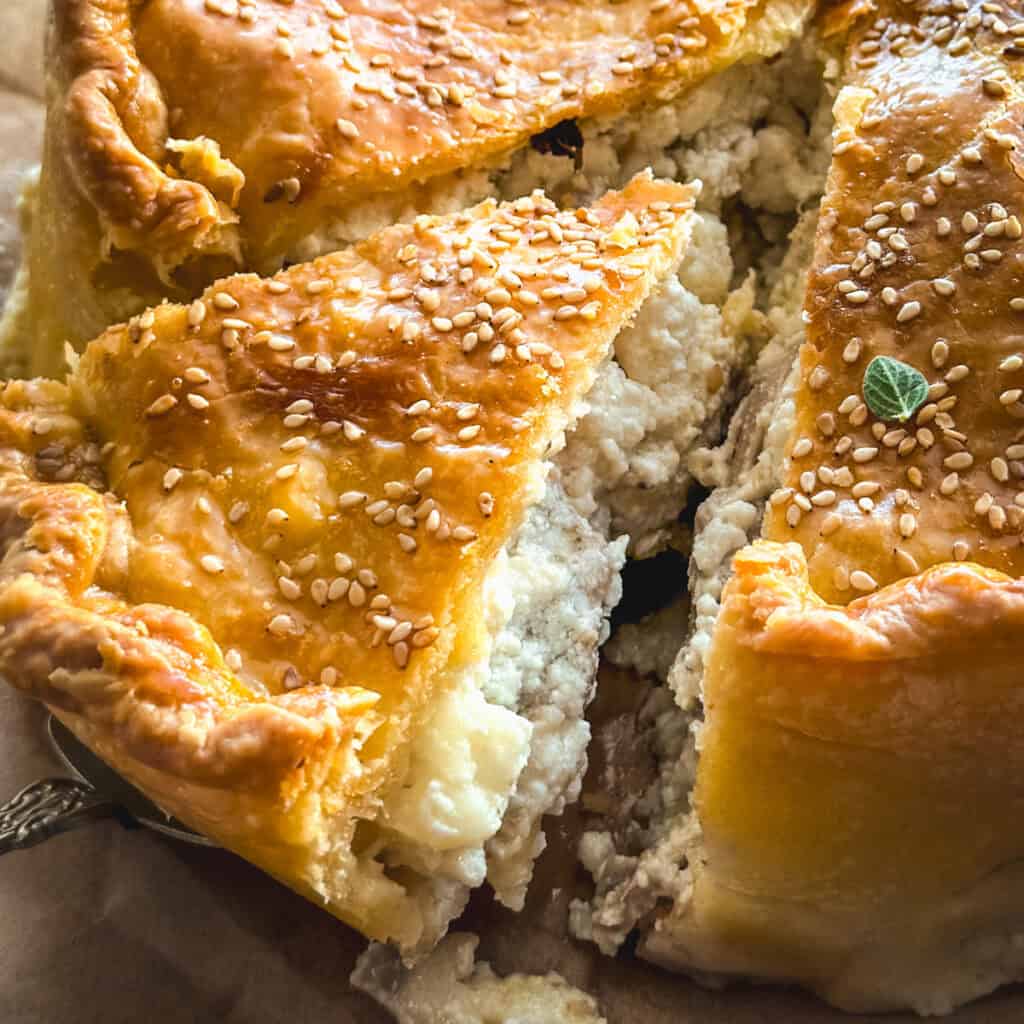


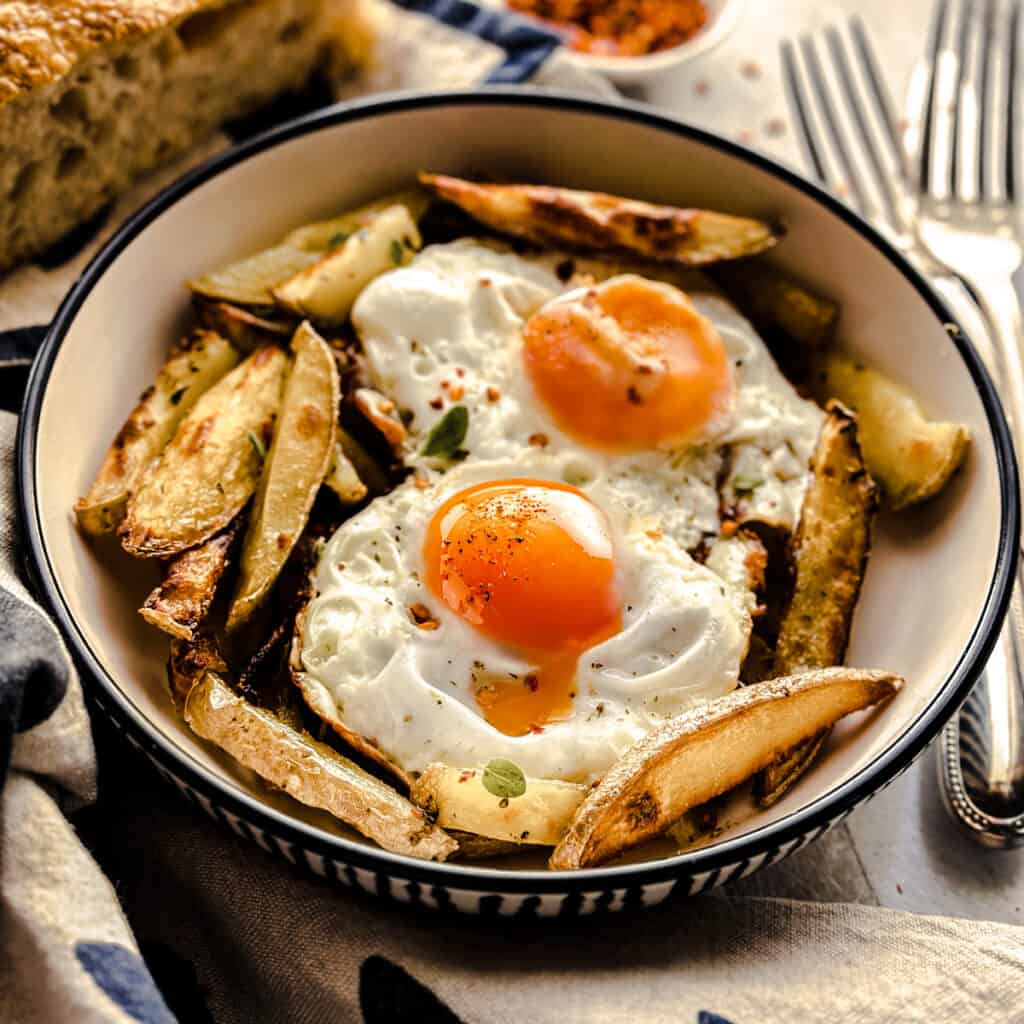

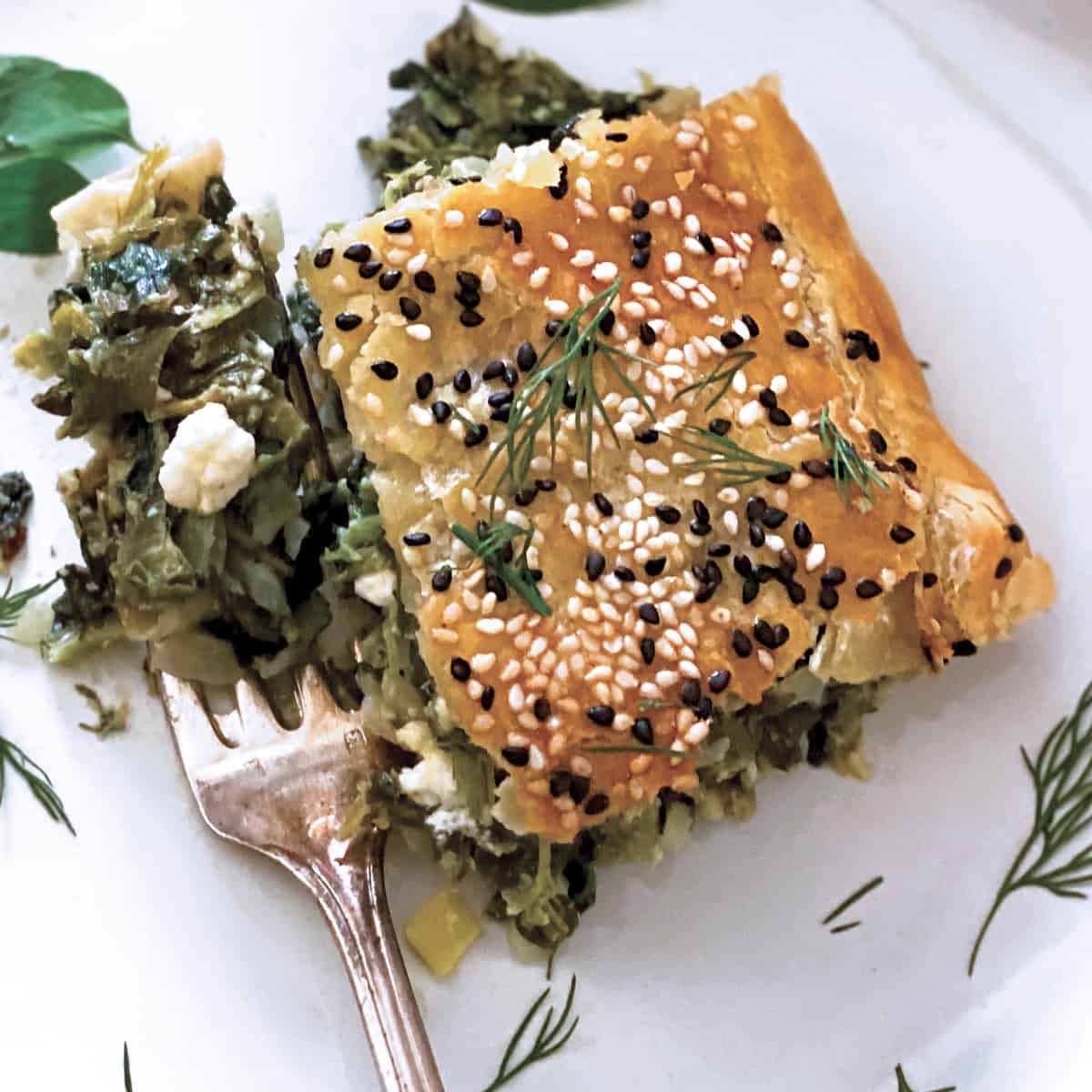

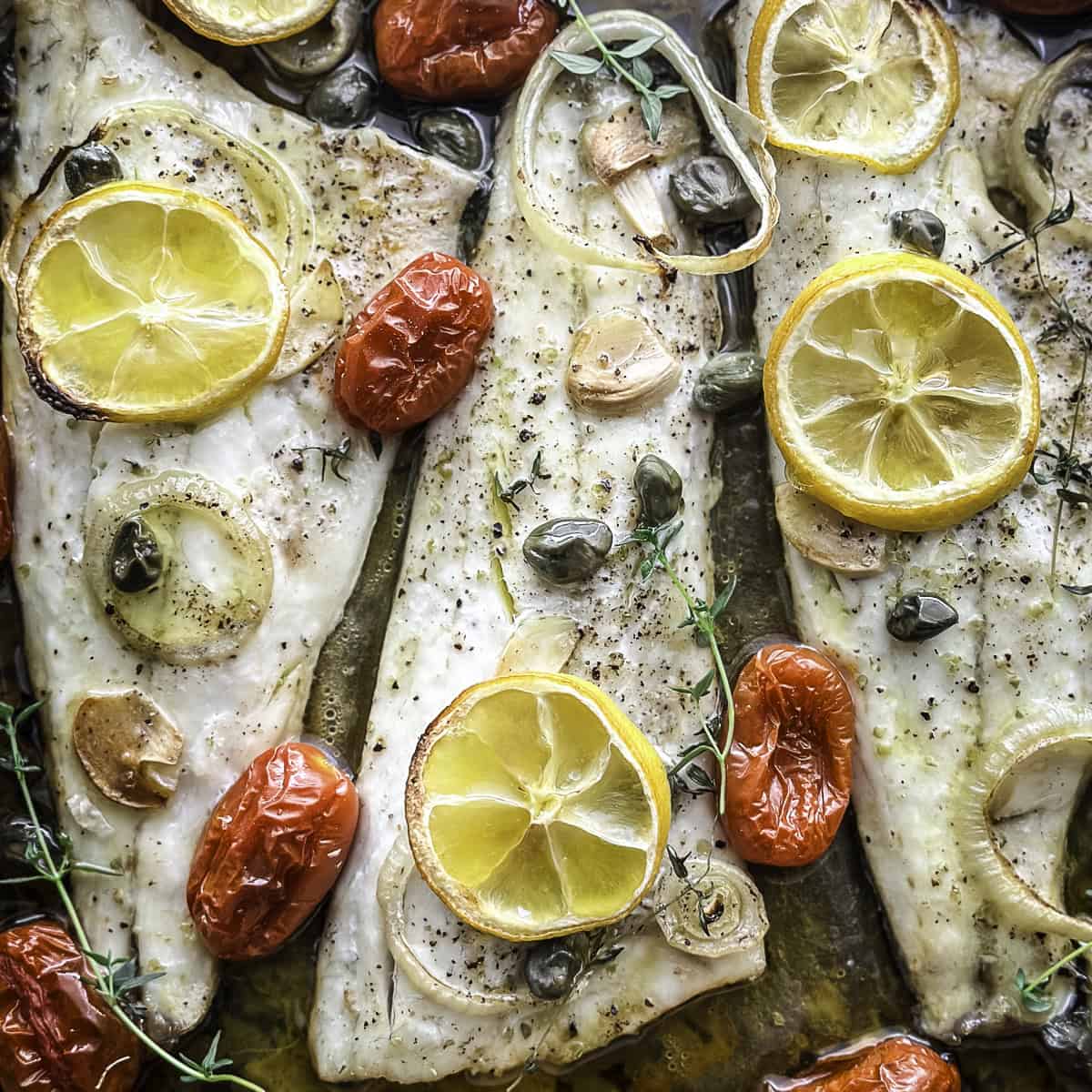
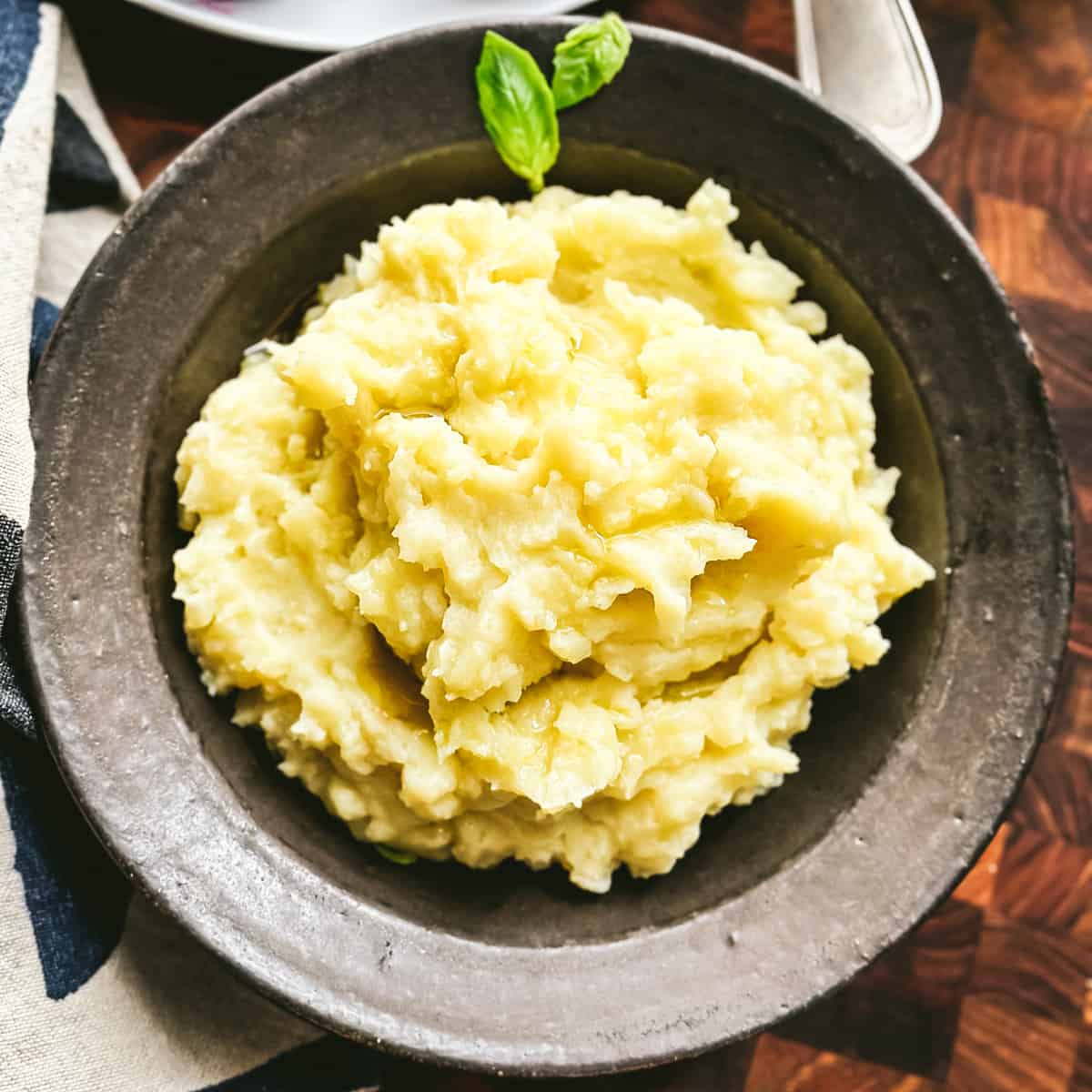
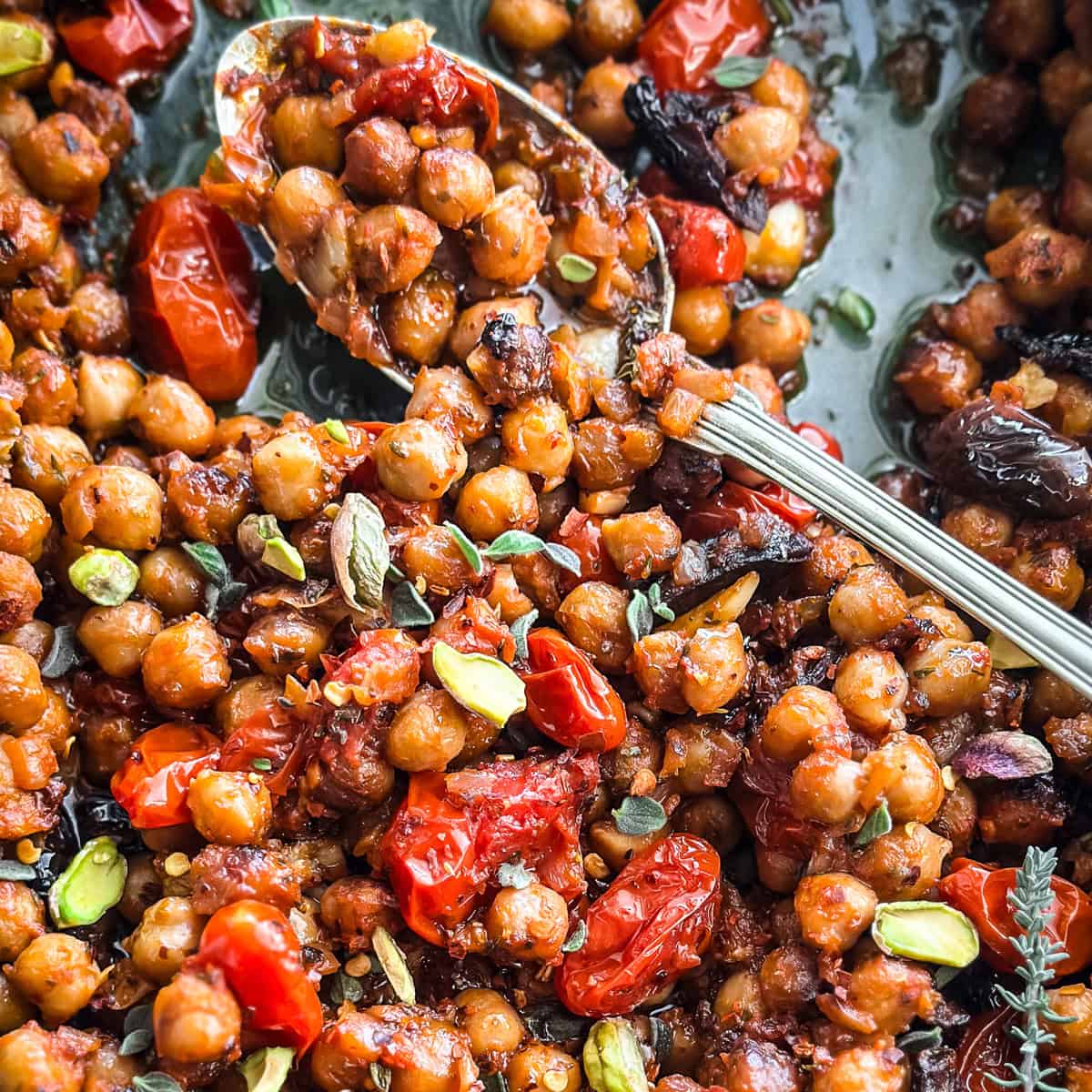
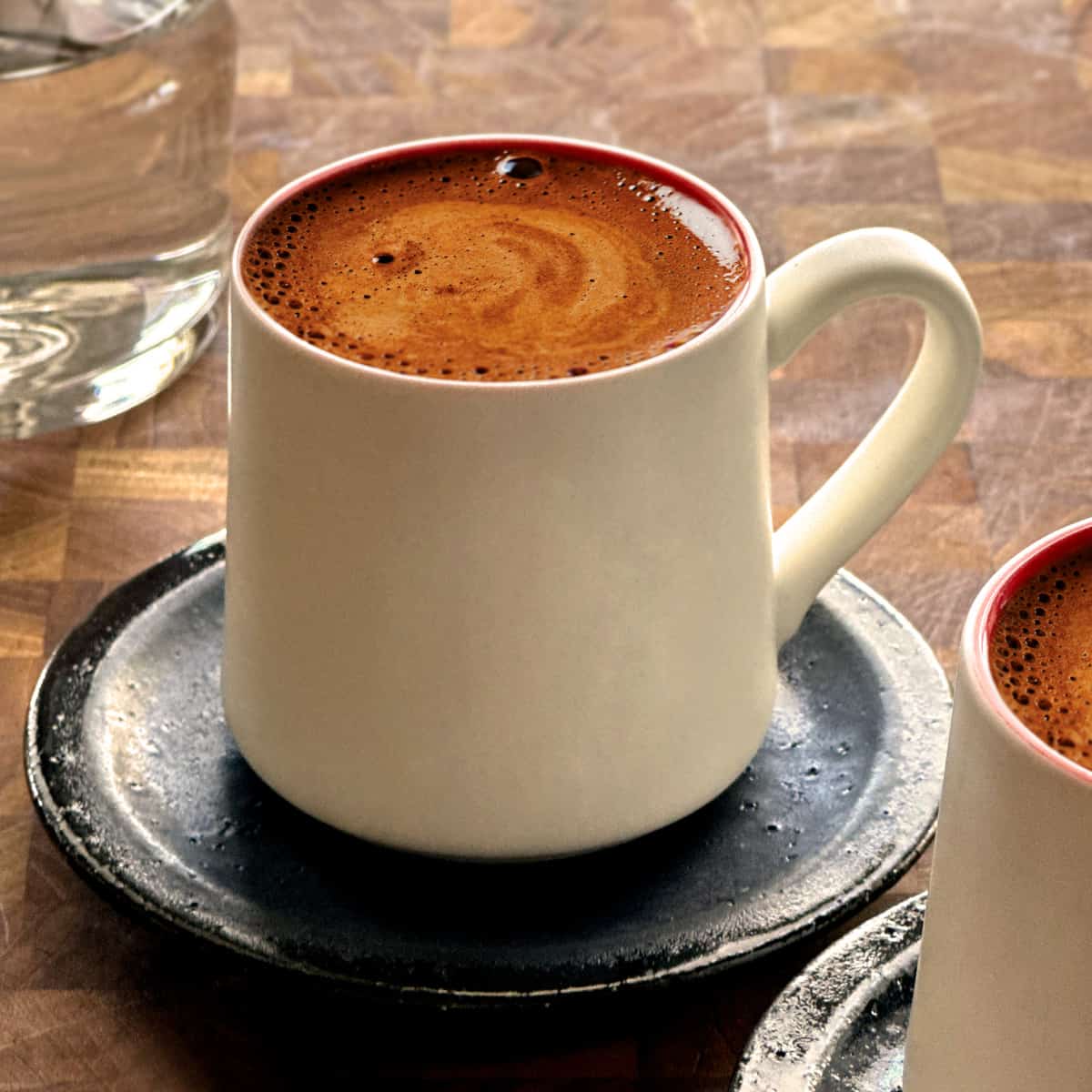
A unique recipe and definitely to try. This is so flavorful . The name of the dish sounds special too.
Ahhh…haven’t had these for so long and I can’t wait to try this recipe. Looks so good and so flavorful!
A really creative way to use grape leaves! Everyone loved this recipe, especially the kids, who never knew about grape leaves! I’m sure I am making this again!
Stuffed grape leaves are such a huge favorite of mine. My husband doesn’t like them but MORE for me!! I’m excited to try your version of stuffed grape leaves. I usually use my best friend’s grandmother’s recipe—hers is a little different, but your look fantastic.
So I’m going to Greece at the end of October and this recipe just got me even more excited than I already am. Yours looks AMAZING! I cannot wait to these next week! Thank you so much for sharing!
We love stuffed grape leaves. My husband used to buy from Costco. Now that we stopped premade store-bought food. This recipe is handy for us! Thank you!
Many thanks for sharing this recipe. I never dared to try dolmadakia, because I had no clue how to roll them. So great to have a step by step description here. Now I can finally try making them. I am so looking forward to it.
Mmm… I think I just heard my tummy growl. lol. Thank you for making me hungry!
This was super delicious and my hubby loved it. That’s a big win for us!! Thank you for sharing!
This recipe looks and sounds so unique! Also looks so yummy! Love it!
Love stuffed grape leaves, but was very disappointed by how bland this recipe was… Next time I plan to double the herbs. Does anyone else have suggestions for improvements?
Hi Andrew,
I am so sorry you found the dolmadakia bland. This version is the “naked” one, if you will, and the flavor is mild. You can definitely double the herbs. That is never a bad thing, and use more seasoning.
Bellow is another version of Cretan dolmadakia.
You can add a medium onion, two medium zucchini and one medium eggplant, grated in the rice mix.
If you want to build flavor, before you start rolling the leaves, saute the rice mixture for 3-4 minutes.
In a little olive oil in medium heat, onions first, let them sweat, add the rice saute until it becomes translucent, and add the grated veggies, herbs, etc. Remember to season.
Let me know if you tried this version.
Thank you for trying the recipe,
x Jenny
I tried dolmadakias today in a Greek salad for the first time. I didn’t know about this Greek cuisine staple. So, I started researching online and found this website. I would enjoy trying to make these at home because I like to cook recipes from different cultures. I think they are good to go with a salad. They have a delicate, but tangy taste. I really appreciate the pictures showing the steps to follow. Thank you for sharing your heritage and culture with us.
Thank you so much for your kind words. You are so sweet, Soraya!
So glad you tried dolmadakia. It’s a humble dish that we all love in Greece.
x Jenny